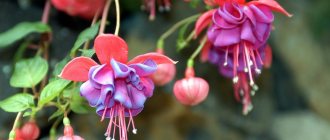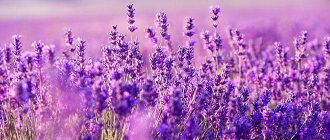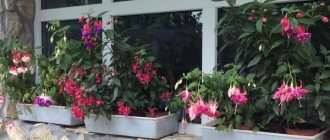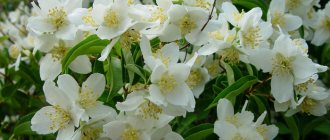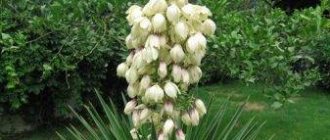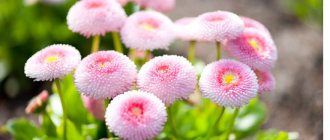Fuchsia is a gorgeous flowering plant. People call her a “ballerina” for the special shape of the flower, similar to the fluffy tiered skirt of a dancer. It is for the original flowering that many value the plant. Fuchsias have long been a model of grace. These plants, which survived a period of decline in popularity, are rapidly regaining their former positions in the new millennium. The reason for this is the breeding of luxurious varieties, after contemplating the beauty of their blossoms it is even inconvenient to talk about boredom.
Fuchsia is a popular beautiful indoor plant.
Recently, fuchsias have become very popular not only in Europe and America, but also in Russia. They can also be grown in hanging baskets and formed into standard trees or beautiful bushes. Fuchsias are good both as indoor plants and as garden and indoor plants that spend all the warm time outdoors. But in the frosty Russian winter they will die in open ground, so in the fall fuchsias need to be moved from the garden to a cool place for the winter.
Description of the plant and features of fuchsia
The first mention of fuchsias was recorded about 300 years ago, and since then, breeders have developed more than a thousand varieties of these beauties. There are ampelous and bush varieties of fuchsias.
Spectacular, graceful, fuchsia has become famous for its unique flowers, which cannot be confused with any other plant. Flowers are double, semi-double and simple. The group for home floriculture is varied in shades. There are white, lilac, pink, beige, violet. You can often observe combinations of 2-3 shades in the structure of one bud.
The fuchsia plant (Fuchsia) is a member of the fireweed family.
Fuchsia, a well-known houseplant, has acquired a “second wind” with the production of hybrids capable, firstly, of propagation by seeds, and, secondly, of blooming relatively soon, 4-5 months after sowing. Since several species are mixed in the “blood” of this hybrid, it is often called hybrid fuchsia (F. x hybrida). But it is not only the ability to bloom in the year of sowing that allows fuchsia to be classified as an annual plant. More importantly, it blooms all summer in open ground. At the same time, fuchsia remains a perennial; in winter it can be kept in a cool, bright room and cut out in the spring. Fuchsias bloom from July until the first frost.
Indoor fuchsias (Fuchsia hybrids, Fuchsia x hybrida) are much more elegant than those that grow in natural conditions. In nature, they resemble small spreading trees or lush shrubs, strewn with clusters of fragrant flowers. Fuchsia appeared in Europe in the 17th century thanks to the explorer and botanist Leonard Fuchs. At first it was considered a great curiosity and was grown in the winter gardens of nobles.
Gradually, hybrid varieties were developed that were more adapted to northern latitudes. This is how bush, ampel and semi-ampel forms of fuchsias appeared. Today, it is very rare to find species of fuchsias in indoor culture; in the vast majority of indoor fuchsias, they are hybrids.
Fuchsia has enormous potential and many advantages.
Fuchsias provide a considerable choice of possibilities for changing the form of cultivation. They are good both as hanging crops or graceful vines with shoots hanging down, and as graceful bushes, and as plants formed on a figured support. They can even be driven out in standard form, forming trees of amazing beauty.
Today, fuchsias are represented by spreading, ampelous and upright growing varieties with a height of 30 to 70 cm, with flowing, straight or creeping, partially woody shoots, up to 70 cm long. The shape of a fuchsia bush can be easily controlled by pinching. The leaves are large to medium-sized, ovate-lanceolate or oval with pointed tips and pronounced veins, most often with a serrated edge.
The most attractive thing about fuchsias is their flowers. They are considered exemplary graceful not only because they droop down and elegantly hang on their stalks. The flowers of this plant have been compared to dancers and their spectacular skirts. Some have completely different associations - with elegant lanterns. And the structure of the flower really has a lot in common with the outfits of ballerinas. In fuchsias, the flower consists of a calyx and a corolla. The elegant calyx resembles a simple flower with petal-shaped sepals, on which lies a bell-shaped corolla.
Ordinary fuchsia is far from being as simple as it might seem: it has enormous potential and many advantages.
Small classic varieties with 4-5 corolla petals compete today with varieties with giant double flowers, the corolla of which offers you to admire the most bizarre curvatures and shapes. Narrow and long, short and wide, large, small, twisted, with ruffles - fuchsia corolla petals can be anything you want. But it’s also worth taking a closer look at the calyxes: in some fuchsias the sepals are straight and lanceolate, in others they are ovate and drooping down, in others they are raised up. And the stamens, which are always longer than the corolla, only emphasize the gracefulness of the plant.
The fuchsia color palette today can surprise even artists. The calyx and corolla almost always differ in color. A light cup and a dark corolla, or vice versa, contrasting tones or similar shades, completely different in color saturation, are mixed in limitless variations, and sometimes we are not even talking about two-color combinations: transitions, play, variegated spots significantly expand the idea of the palette. Fuchsia colors include white, cream, light green, blue, lilac, violet, red and pink.
Varieties and types of fuchsia with photos
The genus Fuchsia includes 107 species. More than half of this list are residents of the tropics and subtropics of South America. The species diversity of the genus is amazing! There is everything here: from miniature shrubs to three-meter-high trees. We offer views with photos and descriptions of the most famous and spectacular ones.
- Fuchsia magellanica (Magellan) is one of the most unpretentious and cold-resistant species. This is a fairly tall deciduous shrub - up to 1.5 m in height. Used in garden design when decorating walls and for forming hedges.
- F. corymbiflora var. Alba is a spectacular cultivar with exquisite bells of a delicate lilac-white color. The homeland of the maternal species, on the basis of which the hybrid was bred, is the mountain slopes of Peru and Ecuador.
- Fuchsia Checkerboard is a variegated version obtained by crossing two species. Abundant branching gives a bush with dimensions of 90 x 90 cm. It is recommended for planting in open ground. If we are talking about central Russia, for the winter the bush is completely pruned and transferred to a cool room.
Varieties and types of fuchsia with photos and descriptions
A large flowering bush in a container, a standard or ampelous fuchsia will decorate any veranda, terrace or lawn; it is only important to choose the right variety and place.
Our most famous fuchsia is beautiful fuchsia (Fuchsia speciosa), it is also a hybrid (Fuchsia hybrida) - the result of crossing Fuchsia fulgens x Fuchsia splendens (brilliant fuchsia x sparkling fuchsia).
Fuchsia trifoliata.
However, there are several more cultivated species, for example, highland fuchsia Magellanica (Fuchsia Magellanica), its varieties graceful fuchsia (Fuchsia gracilis) and ricartona (Fuchsia magellanica 'Riccartonii') - the ancestors of cold-resistant varieties, as well as heat-loving ones - small-leaved fuchsia (Fuchsia Microphylla) , Bolivian (Fuchsia boliviana) and three-leaf fuchsia (Fuchsia triphylla), which gave rise to triphylla hybrids.
All of the listed species are bushes from 70 cm to 2.5 m in height. Branches can be strong or thin and drooping. Depending on their location and strength, the plant will be compact or spreading.
Among the triphylla hybrids and hybrid fuchsia varieties there are also climbing ones. There are also amazing “weeping” forms with thin long (up to 2 m) shoots, very similar to wild-growing graceful fuchsia. Among the triphylla hybrids, this is the 'Mantilla' variety.
Fuchsia Magellanica 'Riccartonii'.
The Bolivian fuchsia bush is decorated with inflorescences - clusters of long-tubular flowers at the ends of long (up to 30 cm) peduncles.
Fuchsia trifoliate flowers sit densely at the ends of the shoots. Such plants are planted in hanging baskets and balcony boxes.
Description of fuchsia varieties
Rohee's New Millenium One of several varieties with a black skirt. Unusually bright dark crimson sepals with a blue-purple almost black skirt, flowers of medium size, semi-double. Elongated foliage. The bush is weak-growing, highly branched, only moderate pruning is possible. Relatively unpretentious. Flowering early, abundant, long lasting. South Gate Stipules are light pink with emerald tips, the skirt is terry pink. The leaves are not large, the plant is medium tall. Flowering is early and long lasting. Suitable for creating a standard form of Vinlast (Veenlust). The combination of white sepals and the beautiful shape of the red (precisely red!) skirt will not leave anyone indifferent. The bush is climbing, weakly branching. Flowering early. Flowers double, large. White Galore White variety with delicate peach shades. Beautiful flower shape, heart-shaped buds. The flower is very large. The bush is climbing, vigorous. Unpretentious. Ballet Girl Bright red sepals with a very terry snow-white skirt. The most terry variety! The plant is compact, bushy, and tolerates heat and direct sun. To create a standard form. Blooms early and abundantly. Unpretentious. Heavy pruning is applicable. Suitable Rohee's Queen Another “black” variety. The bush is semi-climbing, weak-growing, weakly branched. Pruning is moderate. Sharon Allsop One of the best minis! The dwarf tree is simply strewn with wonderful red and white flowers. The bush is climbing, with several branches. The flowers are medium-sized, double. Flowering is abundant and long lasting. Unpretentious, withstands direct sun. Pruning is moderate. Quasar (Quasar) Climbing bush, weakly growing, weakly branched. White-blue terry variety with very large flowers. It is demanding on growing conditions, only moderate pruning is applicable, cuttings take root poorly and take a long time. The variety is quite capricious, but worth it! Coq-au-vin (Coq au vin) Climbing bush, vigorous. The flowers are double and very large. Flowering is abundant and long lasting. Unpretentious. Needs shaping. Display The bush is erect, highly branched. The flowers are medium-sized, simple. Flowering is abundant and long lasting. Unpretentious. Deep Perple The bush is climbing, low-growing, medium-branching. The flowers are very large, double. Sensitive to waterlogged soil and high temperatures. Bella Rosella (Bella Rosella) Semi-climbing bush, low-growing. Flowering is early, long, moderate. The flowers are very large, double. Relatively unpretentious. Annabel The bush is erect, medium-sized, highly branched. The flowers are double and large. Flowering is very early, abundant and long lasting. Unpretentious. Suitable for forming a standard form.
Bicentennial
Semi-ampel and ampel form. The buds are oblong. The white sepals become light orange over time. The skirt is red with salmon-orange strokes, becoming almost orange over time. The flowers are double and large. The leaves are medium green, medium-sized. The most beautiful variety!
Rocket Fire
Bush form. Large, elongated buds. Sepals are dark pink-red. The skirt is two-color: the upper petals are rich pink-red, the inner petals are bright blue-violet. The flowers are double and huge. Medium green large leaves. A delightful variety - a giant!
Royal Mosaic
Ampel form. The buds are large and round. Sepals are light pink. The skirt is purple with pink highlights. The flowers are large, densely double. Medium green large leaves. The variety will adequately decorate your collection!
Voodoo Maori
Bush form. The buds are large and shaped like a “heart”. The sepals are deep red. The skirt is dark blue-violet. The flowers are huge and double. The leaves are medium green and large. Delightful variety!
Fuchsia Hollies Beauty Holly's Beauty
It has large, slightly elongated buds. The flowers are bright. The sepals are white. The skirt is lilac.
El Camino. El Camino.
Semi-ampelous, abundantly flowering fuchsia with early, abundant, long-lasting flowering. Height up to 30 cm. Double flowers are very large.
Fuchsia Pink Marshmallow pink mapshmallow.
Ampel form. White sepals with greenish tips. White skirt with a delicate pink tint. Terry huge flowers. Large light green leaves. Stubbs, USA, 1971. Very large-flowered, profusely flowering variety..
First Lady Fest
Semi-ampelic variety. The sepals are white-pink with greenish tips. The skirt is pink-salmon, warm, pleasant tone, with carved edges of petals, terry. The flowers are very large.
To see photos, go to the fuchsia photo catalog.
Ask your question, find out about the availability of fuchsia seedlings - go to contacts
Vorontsova V.Yu. tel
Fuchsia fulgens
This species comes from the mountains of Mexico. The height of this evergreen shrub is about 100–200 cm, its branched stems are bare. Large leaf plates have a heart-shaped or elongated ovoid shape, they are bare, serrated along the edge. Their width is about 12 centimeters, and their length is up to 20 centimeters. At the tops of the stems grow hanging racemose inflorescences, which consist of pale red flowers with petals about 10 centimeters long, as well as a corolla tube tapering to the base up to 10 centimeters long. The fruit is a berry that can be eaten. This species blooms throughout the summer.
Fuchsia fulgens.
Bolivian fuchsia (Fuchsia boliviana).
Fuchsia hybr. (Fuchsia) / Pink Ballet Girl
Fuchsia hybr.
(Fuchsia) / Alois Barmbichler Fuchsia hybr. (Fuchsia) / Fuchsita Deep Rose-White
Fuchsia hybr. (Fuchsia) / London 2012 OS
Fuchsia hybr. (Fuchsia) / Saskia Vander Heyden
Fuchsia hybr. (Fuchsia) / Applause
Fuchsia hybr. (Fuchsia) / Machu Picchu
Fuchsia hybr. (Fuchsia) / Mantilla
Fuchsia hybr. (Fuchsia) / Shadow Dancer Peggy
Fuchsia hybr. (Fuchsia) / Belize
Fuchsia hybr. (Fuchsia) / Lisette Kums
Fuchsia hybr. (Fuchsia) / Pink Galor
Fuchsia hybr. (Fuchsia) / El Camino
A tree or shrub with flexible branches covered with small green or slightly reddish leaves. The leaves are opposite, oval-lanceolate, 4-5 cm long, pointed at the end and slightly serrated along the edge. Blooms profusely and for a long time. Fuchsia flowers come in different colors, simple or double. The flower consists of two parts: a corolla-shaped bright calyx and a tubular corolla with bent leaves. The petals are shorter than the calyx lobes, the stamens are longer than the calyx. After flowering, a fruit is formed - a berry, edible. Fuchsia is native to Central and South America, New Zealand. These are evergreen shrubs, of which there are about 100 species in nature. Many species are cultivated as ornamental plants, and many varieties have been developed.
- white, purple, blue, pink, multi-colored eyes, different color,
- 1
- seedling in a container 0.5-1l
Gospodarstwo Ogrodnicze Zielińscy z unikatową pasją zajmuje się ogrodnictwem nieprzerwanie od 1958 roku, dbając o estetyczne doznania klientów indywidualnych i hurtowych.
Związane jest to z roślinami ozdobnymi do obsadzania ogrodów, ogródków, balkonów.
Fuchsia magellanica
The height of this shrub is 200–500 cm. The surface of the purple stems has slight pubescence. Lanceolate-ovate leaf plates can be alternately arranged or grow collected in whorls of 3 pieces, their edges are serrated. They are about 50 mm long, and purple veins are clearly visible on the surface. Axillary flowers are collected in groups of 4 or are single. The color of the corolla tube is pale red, and the petals are lilac-blue. Flowering begins in the last weeks of spring and ends at the end of summer.
Fuchsia magellanica.
Fuchsia corymbiflora.
Conditions for growing fuchsia
Fuchsias are heat-loving, although there are forms that can tolerate light frosts; they are moisture-loving, but do not tolerate excess water in the soil; they prefer sunny or semi-shaded, windless places with nutritious soils.
Necessary conditions for fuchsia : a light, diffused or semi-shaded place (do not move during flowering), protection from drafts, room temperatures during the active growth phase and, if possible, a cool winter at 5-10 degrees.
Lighting: fuchsia will feel great on eastern and western windowsills with diffused sunlight. These beauties grow well even in partial shade - on northern window sills. Direct sunlight is strictly contraindicated for fuchsias! They are so tender that they get burned immediately.
It grew on my southern windowsill. Although I placed the flowerpot in some shade from a large neighboring plant, it turned out that she was still not comfortable there. Since my eastern and western window sills are already occupied, but the northern ones are not, I placed my beauty not far from the southern window sill (approximately 1.5 m) on the sideboard.
Temperature: at this point, I think, my main mistake was hidden, as a result of which the fuchsia did not bloom. For her, during the active growth phase, a temperature within +19...+24 °C is considered comfortable. And in the summer on my southern windowsill it’s definitely more than +30 °C! In such conditions, the fuchsia leaves lost their elasticity and she did not even think about flowering.
Dormant period: with proper care, fuchsia can bloom from mid-May to November, after which its strength is depleted and it gradually goes into a dormant state. To help her, watering is gradually reduced, fertilizing is stopped completely, and the pot with the flower is moved to a cooler place.
After the leaves fall, the branches are cut to 2/3 of their length, the pot is placed in a shaded room with a temperature no higher than +10 degrees. Water very rarely, as the earthen ball dries halfway. From mid-March, the plant is put into awakening mode, moved to a warmer corner and gradually increasing the daylight hours to 8-9 hours.
If you leave fuchsia in a warm apartment during the winter, it will weaken and may not bloom at all in the spring.
Optimal care : abundant watering with soft water with reduced humidity in winter, active fertilizing from spring to autumn with complex fertilizers will ensure abundant and continuous flowering. It is advisable to maintain average air humidity. Pruning after a warm winter or for shaping.
Planting : when grown in open ground, fuchsias are planted in late May - early June, deepening the root collar by 10-20 cm. 2 weeks after planting, when the plants are well rooted, they grow again and soon bloom. Fuchsias from all groups tolerate the first autumn frosts very well, undergoing the necessary hardening before resting. Flowering in the Moscow region lasts until the end of September - beginning of October.
Soil and replanting fuchsia : any light, loose and neutral soil will do; The plant is replanted as needed or annually during a warm winter.
Feeding: fuchsia is sensitive to lack of nutrients. I apply fertilizer every week, but in portions half as large as indicated in the instructions. I alternate organic and mineral complex fertilizers for beautifully flowering indoor plants. Fuchsia needs active feeding from spring to autumn.
Caring for fuchsias must necessarily include regular pruning or, to be more precise, pinching.
By analogy with other plants, I started adding wood ash to the surface of the soil once every 14 days (1 level teaspoon).
Fuchsia propagation methods : cuttings and seeds.
Diseases and pests : aphids, whiteflies, spider mites, powdery mildew.
Fuchsia in winter
At this time, flowers are not watered more than twice a month. It is necessary to provide the necessary coolness for the rest period. The air temperature at this time of year should not be higher than +17°. If this is not done, fuchsia will not be able to rest and will enter the growing season considerably weakened. This will lead to a halt in development and even a lack of flowering.
No feeding required. They are needed only during the growing season for the formation of peduncle buds. But pruning fuchsia for the winter is not only desirable, but also mandatory. This is especially true for garden varieties grown in open ground.
Growing fuchsia
Although fuchsia is very photophilous, direct sunlight is undesirable for it. On a hot afternoon, leaves and flowers can get severely burned.
Lush growth and abundant long-term flowering are promoted by abundant watering, frequent spraying, regular fertilizing, nutritious soil and fresh air.
Western or eastern windows are best suited for growing fuchsia because it needs a lot of bright light.
The plant will feel great outdoors in the summer and, what is very important, will suffer less from pests. In a closed and hot room with dry air, it will most likely be attacked by aphids, whiteflies, and spider mites. If this happens, first of all you should increase the air humidity and treat the bush with appropriate protective agents. It is better to do this outdoors - in calm weather, in the shade, strictly following the dosage instructions.
Fuchsias should be planted in light-colored pots, as they are less exposed to the sun than black or dark brown ones.
The substrate in the fuchsia pot should always remain moderately moist. To avoid stagnation of moisture, pour a drainage layer of expanded clay or small pebbles onto the bottom of the pot. The soil should be quite loose.
In rooms with dry air, fuchsia is sprayed as often as possible, but never done outdoors in sunny weather. Any varieties of fuchsia do not tolerate long periods of heat, especially if they are in direct sun.
Fuchsia needs regular ventilation, but it must be protected from drafts, as they can cause its death.
Fuchsias are fed once a week with liquid fertilizers for balcony flowers. Feeding begins from the moment the first buds appear in the spring. In September, feeding is gradually reduced to allow the shoots to ripen.
Faded fuchsia flowers are regularly removed to encourage the plant to form new buds.
Before the first night frosts, fuchsias are removed indoors. Optimally - in a bright, well-ventilated place, with a temperature of 5-10 ° C. The leaves are removed so that pests and fungi do not overwinter on them. Water the fuchsias in winter so that the earthen lump does not dry out. In the spring, when the plant begins to grow again, watering is gradually increased. When the threat of night frosts disappears, it is taken out into the open sky.
To prevent such leaps in development, it is necessary from time to time to trim long shoots that stray from the desired contour.
Fuchsias undergo regular anti-aging pruning so that the plant does not become bare. In the fall, before bringing them indoors, the shoots are cut by a third or two-thirds. In spring, the shoots are shortened again by 2-3 pairs of leaves. The shoots of ampelous fuchsias are trimmed so that they slightly hang over the edge of the pot.
Fuchsias are undemanding to soil. Adult plants can be planted in any light fertile soil with a neutral reaction, with the addition of high-moor peat, sand and perlite. You can add a small amount of clay, which will retain nutrients in the soil. For adult plants, we can recommend mixtures of turf soil, peat, humus and compost (2:1:1:1) or leaf soil, peat and sand (3:2:1).
Every spring, fuchsias are transplanted into a new substrate from a mixture of turf, humus, leaf soil and sand (2:2:2:1). The pots are larger than the previous ones by 2-3 cm in diameter.
During flowering, you should not move the fuchsia from place to place or turn the bush, as this can lead to the dropping of buds and flowers.
In order for fuchsia to bloom profusely in the garden, do not allow the formation of ovaries.
If flowering ends quickly, the reason may be too warm a winter, excessive or insufficient watering, or lack of light during the growth period.
Waterlogging of the soil is indicated by the appearance of brown spots with yellowish edges on the leaves. Wilted flowers should be removed in a timely manner to prevent the formation of seeds, otherwise the flowering period will be shortened. With proper care, young fuchsias will certainly bloom and delight you all summer with their lantern buds and bright, elegant flowers.
Methods for propagating fuchsia
To create a neat appearance, fuchsia sometimes has to be pinched. Experienced gardeners propagate fuchsia by leaf, for which they separate it from the plant and place it in water. The time for the first roots to appear will be 2-4 weeks, depending on the condition of the mother plant.
You can try planting it directly in a damp substrate, cover it with a plastic bag or an inverted jar and monitor its condition, opening it slightly for ventilation every day.
Rarely, but at home, fuchsia is propagated by seeds. They are immediately planted in separate cups or cassettes.
PLANT FOR SPRING SALES
Maori Maid is a large-flowered fuchsia with colorful double flowers, profuse and long-lasting blooms. The sepals are dark red (dark pink), the skirt is blue-violet with red strokes. The double flowers are very large. This variety is one of the Giant series, all varieties of giant fuchsias have a long flowering period. To enhance tillering at the initial stage of growth, formative pinching-trimming is necessary. Maori Maid is ideal for growing in hanging baskets and makes a wonderful addition to the yard and home.
Read the conditions for placing orders for vegetative plants below
under the product photo in the “Description” window. The same conditions can be read here
: https://galinaseed.ru/buys/delivery/
All vegetative plants marked "PLANT FOR SPRING SALES"
are being prepared for distribution in the spring with 100% advance payment for the order. The price of an item in the vegetative plants section is the full cost of the item. Prepayment is a necessary measure that gives us a guarantee for the subsequent purchase of plants by the customer.
Arranging delivery services is our concern. To choose a delivery method, please indicate your preferences in the comments to your order. If you are in doubt which delivery method is best to choose, please contact us and we will try to choose the most convenient method for you. The supply of planting material is limited!
ATTENTION!
The supplier reserves the right at the time of delivery to change the assortment up to 20%; this can happen if any variety has not grown, disappeared or become ill. In such cases, selection and replacement is at the discretion of the customer, or compensation in monetary terms for the missing variety.
Minimum order of vegetative plants is 14 pcs. for an amount from 1500 rubles. All seedlings are expected from Holland in the first half of February, so the final price for the plant may be adjusted depending on the exchange rate at the time of receipt. Payment must be made within 7 days after placing the order. After payment, you must send all payment details [email protected] If there is a need to additionally order any more plants, this can be done in subsequent orders with the obligatory note in the comments field to the order “Combine with No...”.
Number of plants to order per
Propagation of fuchsia by cuttings
For cuttings, you should take young fuchsia cuttings. Slightly woody fuchsia cuttings will also produce roots, but the process may take a little longer. The length of the fuchsia cuttings may depend on the variety, since there are vigorous and very compact varieties of fuchsias. On average, the length of a fuchsia cutting can be 10-20 cm. Before placing the fuchsia cutting in a container of water, it is necessary to remove all lower leaves that may come into contact with water. Touching water, fuchsia leaves can begin to rot, the infection spreads quickly and fuchsia cuttings can rot before they have time to take root.
Propagation by cuttings is best done at the same time as pruning.
You can also cut the remaining leaves by half if they are too large, since excessive evaporation of moisture through large leaves can weaken the fuchsia cutting, which does not yet have its own roots. If, nevertheless, the leaves of the fuchsia cuttings have lost their turgor, place the glass with the cuttings in a greenhouse or simply cover with a transparent bag. Regular filtered water will do. It makes no sense to use special hormones for rooting fuchsia, since fuchsia cuttings readily and quickly produce roots.
It happens that already on the fourth day after cutting the fuchsia cuttings, the first roots appear. On average, the process of root formation in fuchsia takes 10-14 days. There is no need to wait for the fuchsia cuttings to grow long roots. You can plant fuchsia in the substrate as soon as several young roots appear on the cuttings.
You can propagate fuchsias by cuttings at any time of the year, but it is best in the spring, when all living things begin to grow. Since fuchsia loves cool weather, in summer, due to high air temperatures, fuchsia propagation is difficult - cuttings often rot before they have time to take root. The problem of fuchsia propagation in summer can be solved if the cuttings are kept in a room with air conditioning. Also, you may encounter problems with fuchsia propagation in the fall. The fact is that fuchsia has a dormant period, which lasts from mid-October to the end of January. During this period, all vital processes in fuchsia slow down.
To collect seeds from indoor fuchsia, its flowers will require artificial pollination.
The second method of propagating fuchsia is by cuttings. Freshly cut fuchsia cuttings are immediately planted in a substrate (this can be a peat tablet, vermiculite, perlite, sphagnum). The disadvantage of this method is that fuchsia cuttings planted without roots must be placed in a greenhouse, since the fuchsia leaves will certainly lose turgor. But fuchsias very quickly get used to the greenhouse, that is, to high air humidity. When the time comes, the rooted cuttings should be removed from the greenhouse, and they will have to be adapted to normal air humidity for some time. Unadapted fuchsia cuttings may lose some turgor during a sudden climate change.
Conditions
delivery April 21*, Friday
- Next pickup is April 21* , Friday
- 400 rub. for orders from 600 to 3000 rub.
- For orders worth more than RUB 3,000. delivery as a gift .
- Orders worth less than RUB 600. (excluding delivery costs) we do not deliver by courier.
* For orders placed before 15:00 Wednesday
Attention! From 12/14/17 to 01/7/18 we operate only in order acceptance mode.
Delivery across Russia
Geography of orders, delivery times by Russian Post, price. More details about delivery by Russian Post >>
Delivery by courier in Moscow
Payment Methods
- Cash to the courier or the administrator of the pickup point
- Transfer to Sberbank card
- Cashless transfer
Pickup in Moscow
Attention! You can arrive to pick up your order after prior confirmation of the date and time of pickup.
Pick-up point Profsoyuznaya metro station
Address: m. Profsoyuznaya , st. Vavilova, 66, Triumfalny shopping center.
- Cost 50 rub.
- Opening hours: from 12:00 to 20:00 Mon.-Fri., from 12:00 to 19:00 Sat.-Sun.
Propagation of fuchsia by seeds
This difficult, but undoubtedly the most interesting method of propagating fuchsia makes sense only for breeding purposes.
The flower of the fuchsia mother plant must be protected from possible self-pollination. It is also important to exclude the possibility of pollination of the fuchsia flower by insects. Therefore, the anthers of a freshly blossomed, or better yet, flower that has not yet blossomed, are carefully and carefully removed. Pollen from the parent fuchsia plant is applied to the stigma of the pistil. Next, you should isolate the flower by putting an insulating bag on it - this will prevent accidental pollination by insects. An insulating bag can be made from available materials - paper, fabric, secured around the flower with threads.
To propagate by seeds, they are placed in soil made of sand and vermiculite.
The fuchsia fruit takes several weeks to ripen.
The fuchsia fruit is carefully cut and the seeds are removed. Now they need to be dried. In a day or two, the seeds will dry and they can be sown. Fuchsia seeds are sown on top of a slightly moistened substrate, without being embedded in the soil. The bowls with seeds must be placed in a greenhouse, in a well-lit place at room temperature. Fuchsia seedlings will appear in about two weeks. After a month and a half or two, the seedlings dive, planting them at a greater distance from each other. After another two months, the seedlings can be planted in separate cups.
Before young fuchsia plants are removed from the greenhouses, they must be gradually accustomed to normal air humidity. Unadapted fuchsia seedlings can suffer greatly and even die if adaptation is neglected.
How to grow "Queen's Earrings"
Growing this beautiful plant is not an easy task: the beauty is very sensitive and capricious. Breeding indoor fuchsia will require knowledge, time, and effort.
- Where to place it? Unless you live in a tropical or subtropical climate, a cool room in a very well-lit area is ideal. There should be sunlight most of the day, but not direct. At home, fuchsia feels great on windows facing east or west.
- Temperature. A resident of the subtropics reacts equally poorly to both low and high air temperatures. Desirable temperature limits for growing fuchsia indoors: 18-25°. At higher or lower temperatures, the plant stops forming buds, the foliage falls off, and growth slows down.
- Watering. From spring to autumn, especially during the flowering period, abundant watering is required: the soil should always be slightly moist. However, remember, due to excess moisture, the leaves fall off and the buds wither without opening. In hot summer weather or when the air in the house is too dry, the plant must be misted frequently to create a humid environment. Be careful: water should not get on the petals! From November to March, watering is reduced to the required minimum - once a week.
Fuchsia diseases
It has been noticed that most often fuchsia is affected by gray mold. It is enough to fail to keep track of the amount of moisture added several times or not to remove the water from the tray, and alarming spots and a grayish coating appear on the lower leaves and stem.
The bush becomes affected by spotting if it is watered too often in winter.
To avoid trouble, I started using Glyokladin tablets. The drug acts as a preventive and therapeutic agent, destroying the cells of pathogenic bacteria and fungi. It is economical and safe for pets. According to the instructions, the tablet must be buried 6-7 centimeters into the soil when replanting the plant. When I saw the insidious coating, I simply stuck it in the pot, reduced the watering, and sprayed the leaves with Epin. In my case, the set of measures worked, and the fuchsia became noticeably brighter.
Root rotting
Fuchsia loves abundant and regular watering, but sometimes fungal rotting of the roots occurs in fuchsia due to excessive waterlogging. The following symptoms indicate this: the leaves become limp and lose their shine, despite the moist soil. The plant dies quickly
Control measures:
- Unfortunately, the plant most often cannot be saved, either by adjusting watering or by replanting. Even cuttings from such plants, as a rule, no longer take root.
Pests and diseases of fuchsia
Fuchsia in a pot is sensitive to attacks from whiteflies, mealybugs, aphids and mites. You should also be careful with soil-borne fungal mycobacteria, which dry out and weaken the leaves. Particularly large losses are possible in the case of so-called gray mold. Symptoms of infection:
- gray spots on the inside of the leaf,
- deformation of the edge of the sheet plate,
- wilting and necrosis of a large number of leaves and branches.
In all of the above cases, saving the bush can only be done with the help of systemic drugs (“Actellik”, “Angara” and others).
Fuchsia pests
The flower is occasionally attacked by spider mites, aphids and whiteflies. To prevent their appearance, I spray the leaves with Karbofos twice a season. Usually such an event is carried out on a large scale so that pests do not move from one flower to another.
The most common pest of fuchsias is the whitefly. These are small (up to 2 mm) white flies. They got their generic name because both pairs of wings are covered with white pollen. Externally they look like a microscopic moth. Large colonies of these insects, adults and larvae, live on the lower surface of the leaf. They are easy to notice, since when shaking the foliage of the plant, the flies fly up en masse.
The larva has 4 instars. In the first, she is mobile, with legs and antennae. Its task is to find a suitable place for attachment on the sheet.
In subsequent instars, the larva is no longer motionless: it firmly “sucks” to the leaf and sucks out the juice through a stylet immersed in the tissue. During this period, the larva resembles a transparent flat scale.
During mass reproduction, such scale larvae completely cover the leaves. The consequences of this lesion are yellowing of the leaves, shredding of flowers, and drying out of the shoots. Like other sucking insects, the whitefly secretes sweet honeydew on which sooty fungi develop. The whitefly is also dangerous as a carrier of viruses that cause plant diseases.
At the fourth instar, the larva turns into a pupa. It changes greatly, becomes convex, opaque, and is covered with waxy secretions on top.
After molting, the pupa turns into an adult insect.
There are several types of whitefly: citrus, greenhouse, tobacco.
Citrus whitefly harms subtropical trees and shrubs in the south of the Krasnodar Territory and in greenhouses.
The greenhouse whitefly is a species of tropical origin. Does not overwinter in open ground. But in greenhouses it is harmful all year round. Gives 5-7 generations per year.
Tobacco (or cotton) - outwardly does not differ from the greenhouse one, but has some peculiarities in development. It is highly resistant to pesticides.
Control measures:
Good results are obtained by watering all plants with Aktara 3-4 times (4 g of the drug per 5 liters of water)
Plant sap becomes fatal to pests. Repeated treatment is necessary because after treatment only those stages of the pest that feed on the plant sap die.
It is better to alternate treatments with Aktara and Confidor. Since the use of only one drug can contribute to the emergence of a resistant generation of the pest.
Washing plants with soapy water also complements insecticides well. This solution should be left on the plant for about 1 hour, and then rinse the plant with lukewarm water, manually washing off the larvae on the underside of the leaves.
To reduce the number of adult insects, you can use yellow glue strip traps, where insects fall when disturbed by shaking the foliage. But only the use of insecticides gives a guaranteed result.
Red spider mite
This is a very small arthropod insect (0.25-0.4 mm), reddish in color, found on the underside of leaves.
The mite sucks the juices from the plant. The surface of the leaves is first covered with individual pale spots, gradually the area of damage increases, the spots merge, the leaves turn yellow and die. A barely noticeable white web sometimes appears under the leaves. Very often, the mite becomes active in dry conditions at high plant temperatures.
Control measures:
- Treat (spray) the plant with the preparations “Agravertin”, “Fitoverm”, “Confidor”.
- Remove affected leaves.
Prevention : Frequently spraying fuchsia with warm water.

